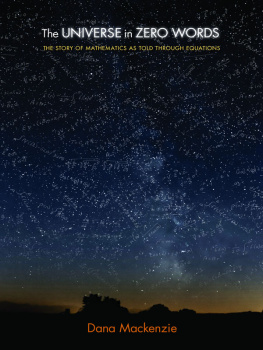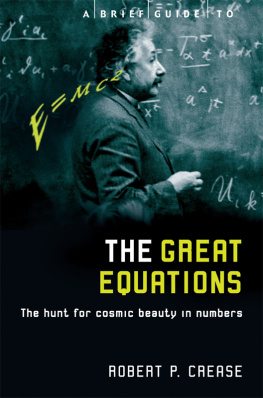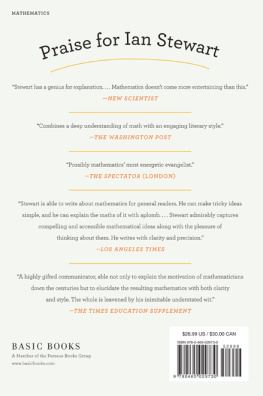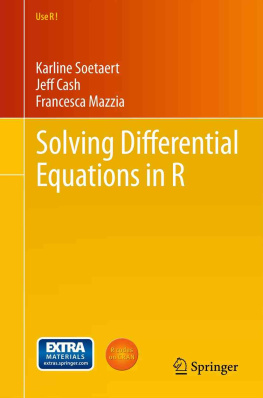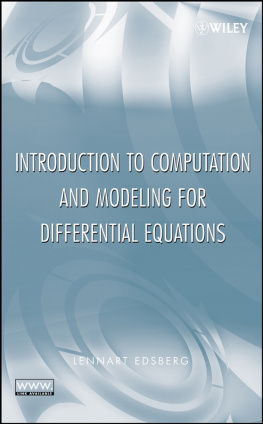
the universe
in zero words
DANA MACKENZIE
the universe in zero words
THE STORY OF MATHEMATICS AS TOLD THROUGH EQUATIONS
PRINCETON UNIVERSITY PRESS
PRINCETON AND OXFORD
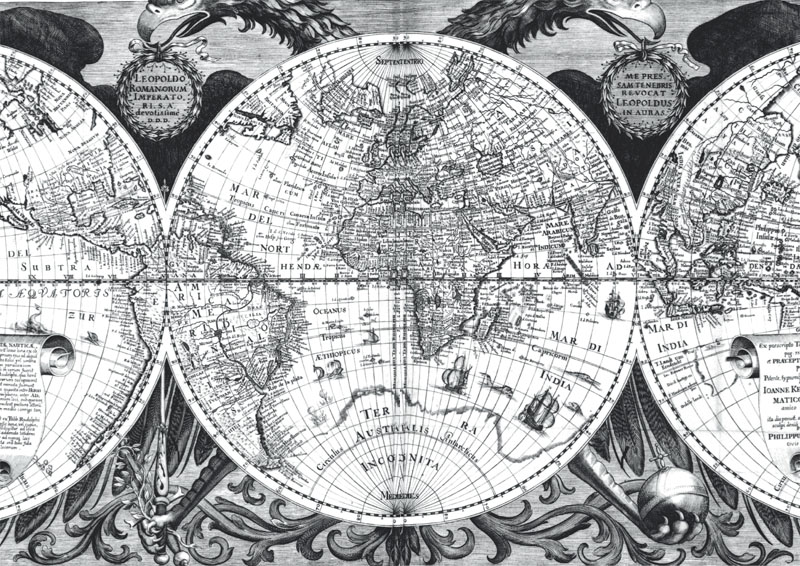
preface
In this book I hope to lift the veil of mystery and secrecy that surrounds mathematics and equations, so that those who are interested can see what lies underneath.
Firstly, let me briefly address some questions of terminology. The words equation, formula, and identity are all used in mathematics, and have slightly different shades of meaning. Formulas tend to be a little bit more utilitarian; you use a formula to solve an equation. Identities are somewhat less deep and have the connotation of something that can be proved purely by symbolic manipulation. For the purposes of this book, though, I am not going to insist on any such distinctions.
You will also frequently encounter the words axiom, theorem, hypothesis, and conjecture, in this book. An axiom is a statement that mathematicians assume as an unproven fact. They may do so because they genuinely believe it is a universal truth, or they may do it just as a convenient starting point.
A theorem is the gold standard of mathematical truth; it is a statement that has been formally deduced from a specific axiom system. It is not subject to experimental error or intellectual fashion except for the fact that the axiom system itself may go out of fashion. Revolutions do occur in mathematics. Usually they occur not because theorems are incorrect but because the assumptions they are based on are judged to be too restrictive, too loose, too imprecise, or not close enough to reality.
A hypothesis or conjecture (the words are synonymous) is a mathematical statement that has not been proved yet, but has substantial evidence in its favor. The evidence may come from similar but weaker theorems, empirical observations or computer experiments. Nevertheless, in mathematics a fact can never be proven by empirical evidence, plausibility, or a statistical test. This is a rule that distinguishes mathematics from the empirical sciences including physics, biology, and chemistry.
THE CHOICE OF EQUATIONS was necessarily a matter of individual taste and preference. Some equations are almost obligatory, such as Einsteins equation E = mc2, probably the most famous equation of all. Other equations will be unfamiliar to all but the most savvy readers, such as the Continuum Hypothesis. Here are some of the criteria I have used to decide what makes an equation great.
1. It is surprising. A great equation tells us something that we did not know before. It may look like a work of alchemy, transforming one quantity into another one that at first seems completely different, yet every step can be explained and justified. The only magic is in the human mind that can discover such connections.
2. It is concise. A great equation has the spare aesthetic of Japanese calligraphy; it contains nothing but the essentials. It says something simple and powerful.
3. It is consequential. I discarded several equations that I consider to be beautiful, inspiring mathematicsbut which in the end have significance only for a few cognoscenti. The equations that make the deepest impression are the ones that revolutionize mathematics, change our view of the world, or change the material possibilities of our lives.
4. It is universal. One of the great attractions of math is that an equation proven today will remain true forever. It is not subject to the whims of fashion, it is the same across the globe, and it cannot be censored or legislated.
Some of the equations presented here are not mathematical theorems, but physical laws or theories, for example, Maxwells equations. Physical theories are generally confirmed by induction from data, or the scientific method, rather than by deduction from a set of axioms. Unlike mathematical theorems, they are subject to empirical evidence and statistical testing, and occasionally, when more sensitive experiments come along, they are proved wanting.
The fact is that mathematics has two faces. First, it is a body of knowledge in its own right; and second, it is a language for expressing knowledge about the universe. If you look at equations merely as a means of conveying scientific information, then you are missing the way that mathematics can unbind our mental straitjackets. If you look at equations only as abstract nuggets of wisdom, then you are missing the subtle guidance nature gives us to ask the right questions.
LEOPOLD KRONECKER , a nineteenth-century German mathematician, once said God created the integers; all else is the work of man. Although it is not entirely clear how literally one should take his witticism, historically he is far from alone in suggesting a divine origin for mathematics. In ancient Mesopotamia, it was a gift from Nisaba, the patron goddess of scribes. Nisaba, the woman radiant with joy, the true woman, the scribe, the lady who knows everything, guides your fingers on the clay, wrote a scribe in the twentieth century BC. Nisaba generously bestowed upon you the measuring rod, the surveyors gleaming line, the yardstick, and the tablets which confer wisdom. On Babylonian mathematical tablets, the solution to a problem was never complete until the solver wrote, Praise Nisaba! at the end.
According to the ancient Chinese, the originator of mathematics was Fu Xi, the legendary first emperor of China. He is often depicted holding a carpenters square. Fu Xi created the eight trigrams in remote antiquity to communicate the virtues of the gods, wrote the third-century mathematician Liu Hui. In addition, he says, Fu Xi invented the nine-nines algorithm to coordinate the variations in the hexagrams. The trigrams and hexagrams are the basic units of Chinese calligraphy; thus, in a loose sense, Fu Xi is being credited with the invention of writing, while, the nine-nines algorithm means the multiplication table. Thus, mathematics was not only divinely inspired, but was invented at the same time as written language.
We can already discern in these accounts three distinct branches of mathematics, which have continued to flow abundantly over the centuries since then. The first branch is arithmetic or algebra, the science of quantity; the second is geometry, the science of shape; and the third is applied mathematics, the science of translating mathematics into solutions to concrete problems of engineering, physics, and economics.
A fourth wellspring is not apparent in the above quotes, and that is the science of the infinitethe analysis of both infinitely large and infinitely small quantities, which are essential to understand any process of continuous motion or change. Mathematicians simply call this branch of mathematics analysis, even though the rest of the world interprets this word to mean something quite different.
Thus, I consider the four main tributaries of mathematics to be Algebra, Geometry, Applied Mathematics, and Analysis. All four of them mingle together and cooperate in a most wonderful way, and witnessing this interaction is one of the great joys of being a mathematician. Nearly every mathematician finds himself or herself drawn more to one of these tributaries than the others, but the beauty and power of the subject undoubtedly derives from all four. For that reason, the four chapters in this book each have a theme, or storyline running throughout, relating to the evolution of the four branches over the ages.
Next page
